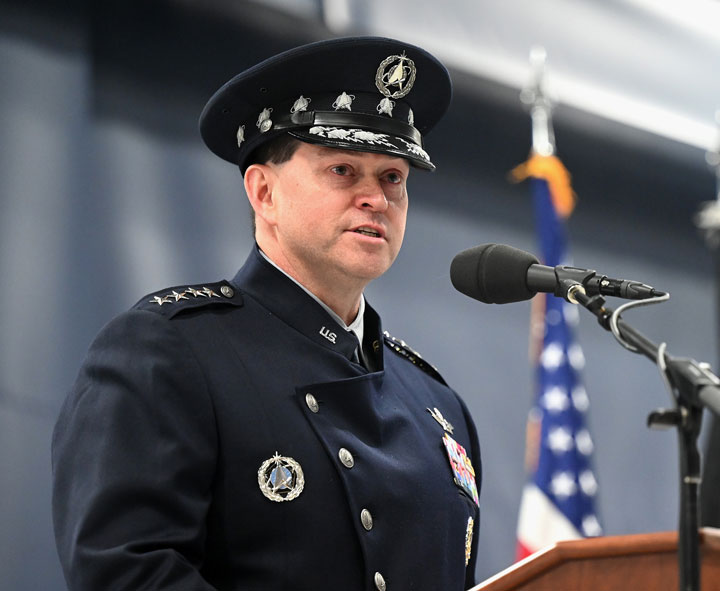ALEXANDRIA, Va. — Gen. B. Chance Saltzman was installed as U.S. Space Force Chief of Space Operations a little over two months ago and has a clear path forward for the 3-year-old service to achieve resilient architectures, strong partnerships and force readiness.
 Chief of Space Operations Gen. Chance Saltzman speaks at the transition ceremony for the chief of space operations at Joint Base Andrews, Md., Nov. 2, 2022. (Source: U.S. Air Force/Andy Morataya)
Chief of Space Operations Gen. Chance Saltzman speaks at the transition ceremony for the chief of space operations at Joint Base Andrews, Md., Nov. 2, 2022. (Source: U.S. Air Force/Andy Morataya)
In an interview with the Space Force Association Jan. 12, Saltzman described his priorities for continuing to build on the “solid foundation” laid by former Chief of Space Operations Gen. John Raymond.
“We’re going to have resilient, ready, combat-capable forces. Technology is not enough. The weapons systems we’re developing are not enough,” he said. “We’re going to put a full set of capabilities together that are resilient in the face of an adversary. It’s going to be a very deterrent force. We’re going to give pause to any nation that thinks they can cause harm in space.”
While new technologies are critical, they are only “half the equation,” according to Saltzman. Joint training in a dynamic, multi-domain environment are paramount to achieve the desired effects in space while denying adversaries the ability to use that domain to achieve a battlefield advantage.
The Space Force chief drew an early lesson from the Ukraine conflict, noting an otherwise “capable” Russian military “didn’t necessarily have the training, they didn’t necessarily have the operational concepts for multi-domain operations.”
Saltzman emphasized the importance of joint training on validated tactics and operational concepts in the space domain. “The side that practices the best will have an advantage early in conflict.”
Replicating a space-based conflict environment with a thinking adversary continues to be a challenge in training today’s guardians. Space is a vast operational domain where it is difficult to control variables even in optimal conditions, spurring demand for mixed simulated and live drills.
In August, Space Force executed its first and largest Space Flag exercise as a Joint National Training Capability. The drill featured live and simulated elements to test combat tactics in space domain awareness (SDA), intelligence, warning and surveillance, satellite communications, as well as navigational and orbital warfare. Space Training and Readiness Command (STARCOM) is also planning a Sky Series of exercises focused on electronic warfare, cyber operations and other specialized communities.
STARCOM Commander Maj. Gen. Shawn Bratton said his command continues to “weigh the value of live training versus training in a simulator.” In a Constellations podcast, he underscored the importance of getting the balance right and working with industry to build the Space Force training complex at Shriever Space Force Base. “We are definitely trying to up our game,” Bratton said, noting the space range is essential to “work out the force” with new tactics, techniques and capabilities.
Keeping the youngest service on top of a rapidly changing space industry is another challenge and a priority for the new Space Force chief. Beyond the role of commercial space partners in providing services and capabilities, Saltzman sees industry playing an increasingly important role in the continued training and education of guardians.
“I want to make sure that when you come into the Space Force that your skills and knowledge of technology, for example, doesn’t atrophy simply because you’re a part of the military,” he said.
Saltzman described an initiative to “keep things fresh in the Space Force” by rotating guardians through private companies and academic institutions to keep current on cutting-edge industry and research initiatives. The Space Force is also looking to award credits to professionals with relevant private sector achievements so they can enter the service at a higher rank.
“Those are the kinds of things that we think are innovative that we’re doing differently from the space force to make sure we get the right talent and hang onto it for as long as we can,” Saltzman said.
Explore More:
Podcast: STARCOM, Virtualized Training for Space and Breaking New Ground
How Do You Prepare Guardians for Space? Maj. Gen. Bratton Explains
Podcast: Dual-Use Technologies, Finding Space Talent and Working with Space Force
NSR Predicts a Big Year for MILSATCOM Terminal Upgrades
